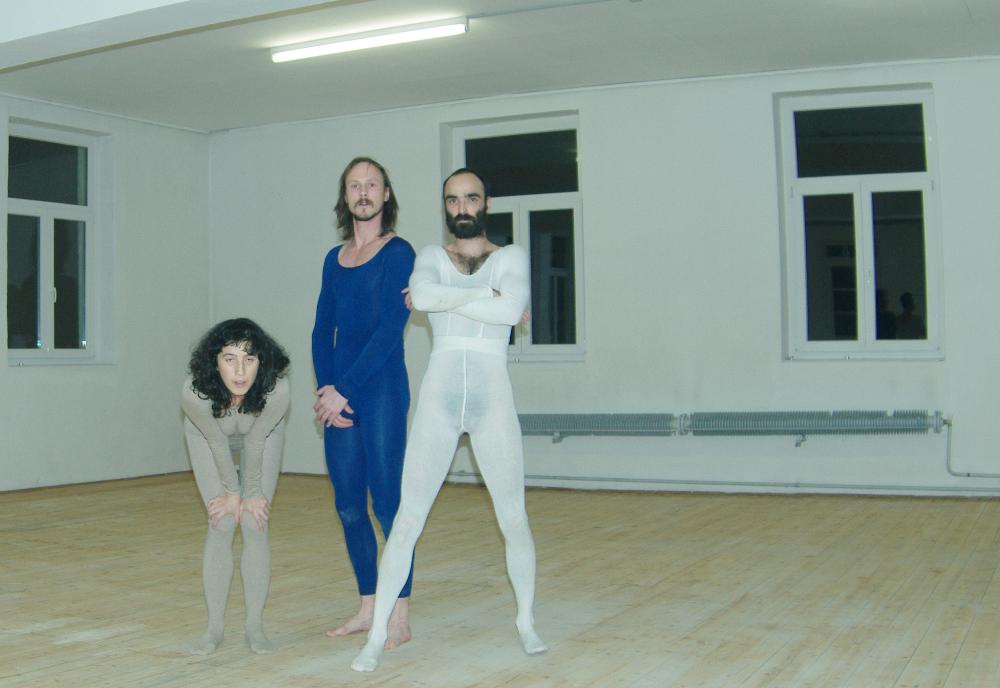the ballet of Albertina Macchiavello Johnny Mclay and Ignatz von stereo
The Ballet of Albertina Macchiavello, Johnny Mclay and Ignatz von Stereo is the second stage work of the ongoing artistic collaboration between Thomas Steyaert and Raúl Maia. Together, Steyaert and Maia explore the artistic practice of non-representational, kinetic communication systems. For this work they have made use of a minimal sense of progression that allows the audience to witness in real time the birth and decay of a physical language. They also propose to reconsider the standard relationships and hierarchies between the physical performance and elements such as light and sound design. The aim is to expand the notion of communication systems to all elements on stage, creating a sense of equality between media and performers by establishing real-time operated dependencies in between the different media present in the performance. This work was premiered in WUK Wien in February 2013.
Full length performance
Concept: Thomas Steyaert (BE), Raul Maia (AT/PT),
Creation/Performance: Albertina Macchiavello (Varinia Vila Canto) (CH/BE), Johnny Mclay (Thomas Steyaert) (BE) and Ignatz van Stereo (Raul Maia) (AT/PT)
Sound: Ivan Mijačević (SLO), Thomas Steyaert (BE), Raul Maia (PT/AT)
Light: Bas Devos (BE)
Production: Ponyhill, La Cagada
Co-production: workspacebrussels, CC De Spil Roeselare, WUK (Werkstätten- und Kulturhaus), Jardin d’Europe
Residencies: workspacebrussels, STUK Leuven, TQW (Tanzquartier Wien), D.ID Dance Identity Pinkafeld
Co-operation: Ultima Vez
With the kind support of Kulturabteilung der Stadt Wien (MA7)
Thank you to Herbert Gnauer and Tomate van Monte for the Technical support.
REVIEWS
Showdown under the stars
Helmut Ploebst 17th, February 2013, 19:42
Masterpiece of Thomas Steyaert and Raúl Maia: "The Ballet of Albertina Macchiavello, Johnny Mclay and Ignatz van stereo"
Vienna - These figures try a togetherness without great theater, but with exquisite movement constellations. At first glance, The Ballet of Albertina Macchiavello, Johnny Mclay and Ignatz van stereo Thomas Steyaert and Raul Maia is seen together with the dancer Varinia Canto Vila, in Vienna Wuk a mystery.
Who are these three, the warmly dressed at the beginning of the play and walk with backpacks into the semi-darkness of the stage? They need to be characters in a drama or narrative ballet. After all, they're wearing name - which is unusual in contemporary dance. But there is no drama, no plot, no ballet. And that turns out in the course of this choreography, is also the key point: it is about a strictly structured Chaotisierung of associations and potential relationships. And a showdown of the postmodern cult reference.
Belly freedom
Only the three pseudo-characters knot under the glow of a single overhead light into each other, then to wander aimlessly on stage. Your movements are beginning to buckle, to clench, escalate. Without stopping Macchiavello, Mclay and van stereo put under a spotlight bow down their clothes until they stand in two-piece midriff from adjacent shirts and trousers. In blue, brown and white variations of the leotard that is how he is often worn in ballet and modern dance.
Obviously, this "ballet" a modification of Steyaerts and Maia's previous work, The Ballet of Sam Hogue and Augustus Benjamin: a refinement with reduced spectrum characters and distorted imagery. It gravitas is mined and produced a poetic reality. See therefore is not a mystery but a Seilakt on the rate used by Nietzsche can preach his Zarathustra: "One must still have chaos in one to give birth to a dancing star."
Led by the star to pull the dancers back at the dance floor and turn it into a black mountain, which rises from a jumble of discarded clothes and backpacks, but at the same time abandoned stereotypes and fictions. Your elaborate sound and brilliant lighting design by Bas Devos make this abundantly unsettling work a real showpiece.
(Helmut Ploebst, THE STANDARD, 18/02/2013)
